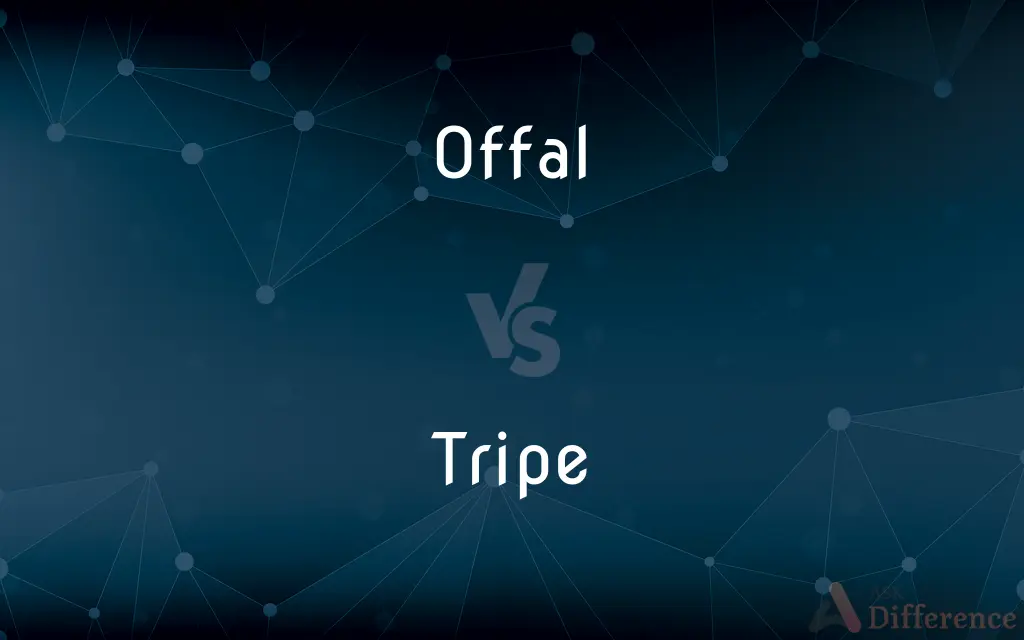Offal vs. Tripe — What's the Difference?
Edited by Tayyaba Rehman — By Fiza Rafique — Updated on April 5, 2024
Offal refers to the internal organs and entrails of a butchered animal, widely used in various cuisines; tripe specifically denotes the stomach lining of ruminants, a type of offal.

Difference Between Offal and Tripe
Table of Contents
ADVERTISEMENT
Key Differences
Offal encompasses a broad category of edible internal parts from butchered animals, including but not limited to liver, kidneys, heart, and brain. It's appreciated in many cultures for its rich flavors and nutritional value, offering a variety of textures and tastes. Tripe, on the other hand, is a specific type of offal that comes from the stomach of ruminant animals like cows, sheep, and goats. It is known for its distinctive chewy texture and is often used in soups, stews, and other traditional dishes.
The culinary applications of offal are diverse, reflecting the wide range of organs it includes. Dishes like liver pâté, kidney pie, and heart skewers showcase the versatility of offal in cooking. Tripe, due to its unique texture and flavor, requires specific preparation methods, such as lengthy simmering to become tender. It's featured in specific dishes, such as the Italian trippa alla romana or the Mexican menudo, which celebrate this ingredient's particular qualities.
Nutritionally, offal is generally rich in proteins, vitamins, and minerals, making it a valuable addition to a balanced diet. For example, liver is exceptionally high in vitamin A and iron, while kidneys are a good source of selenium. Tripe is lower in fat compared to some other offal types and is a good source of protein and nutrients like zinc and vitamin B12, contributing to its dietary value.
Offal holds varying significance around the world, with some cuisines treating it as a delicacy and an integral part of traditional meals. Tripe has its own cultural importance in specific regions, where it's associated with comfort food and traditional cooking, highlighting the unique role of each type of offal in culinary traditions.
The perception of offal and tripe varies globally, influenced by dietary preferences, availability, and cultural heritage. While offal may be embraced in some cultures for its flavor and nutritional benefits, tripe's distinct qualities and preparation requirements might limit its appeal to specific tastes or traditional dishes, demonstrating the nuanced appreciation of these ingredients.
ADVERTISEMENT
Comparison Chart
Definition
Internal organs and entrails of butchered animals
Stomach lining of ruminant animals
Types Included
Liver, kidneys, heart, brain, etc.
Specifically the stomach (various chambers)
Culinary Uses
Diverse: frying, baking, stewing
Often used in soups, stews, requiring lengthy cooking
Nutritional Value
High in protein, vitamins, and minerals
Good source of protein, low in fat, rich in specific nutrients
Cultural Significance
Varied importance across cultures, often considered delicacies
Specific cultural dishes, comfort food significance
Compare with Definitions
Offal
Nutritional content.
The liver is prized for its high vitamin A and iron content.
Tripe
Preparation.
Preparing tripe often involves cleaning and lengthy simmering to achieve tenderness.
Offal
Cultural value.
In many cultures, offal is a cherished component of traditional cuisine.
Tripe
Specific uses.
Tripe is a staple in dishes like French andouille and Mexican menudo.
Offal
Culinary diversity.
From liver pâté to heart skewers, offal is celebrated for its versatility in cooking.
Tripe
Definition.
Tripe, the stomach lining of ruminants, is a unique type of offal with a chewy texture.
Offal
Definition.
Offal includes a variety of organs like the liver and kidneys, offering diverse flavors.
Tripe
Nutritional benefits.
Tripe is a lean protein source, rich in zinc and vitamin B12.
Offal
Global perception.
Offal's appreciation varies widely, with some viewing it as a gourmet ingredient.
Tripe
Cultural dishes.
Tripe's role in traditional cooking highlights its cultural significance in various regions.
Offal
Offal (), also called variety meats, pluck or organ meats, is the organs of a butchered animal. The word does not refer to a particular list of edible organs, which varies by culture and region, but usually excludes muscle.
Tripe
Tripe is a type of edible lining from the stomachs of various farm animals. Most tripe is from cattle, pigs and sheep.
Offal
The entrails and internal organs of an animal used as food
Beef offal
Eating pieces of braised offal turned his stomach
A ban on infective offals being fed to pigs
Tripe
The rubbery lining of the stomach of cattle or other ruminants, used as food.
Offal
Waste material or byproducts from a manufacturing process.
Tripe
(Informal) Something of no value; rubbish.
Offal
Meat, including internal organs (such as liver, heart, or kidney) and extremities (such as tail or hooves), that has been taken from a part other than skeletal muscles. Also called variety meat.
Tripe
The lining of the large stomach of ruminating animals, when prepared for food.
Offal
Refuse; rubbish.
Tripe
The entrails; hence, humorously or in contempt, the belly.
Offal
The internal organs of an animal, used as food.
Tripe
Something foolish or valueless, especially written works and popular entertainment (movies, television).
Offal
A by-product of the grain milling process, which may include bran, husks, etc.
Tripe
An edible lichen, especially rock tripe.
Offal
That which is thrown away as worthless or unfit for use; refuse; rubbish.
Tripe
(pejorative) That (what has just been said) is untrue.
Offal
The rejected or waste parts of any process, especially the inedible parts of a butchered animal, such as the viscera.
Tripe
The large stomach of ruminating animals, when prepared for food.
How say you to a fat tripe finely broiled ?
Offal
That which is thrown away as worthless or unfit for use; refuse; rubbish.
The offals of other professions.
Tripe
The entrails; hence, humorously or in contempt, the belly; - generally used in the plural.
Offal
Viscera and trimmings of a butchered animal often considered inedible by humans
Tripe
Lining of the stomach of a ruminant (especially a bovine) used as food
Tripe
Nonsensical talk or writing
Common Curiosities
Why is tripe often cooked in soups and stews?
Tripe's chewy texture softens with lengthy cooking, making it ideal for soups and stews.
What is offal?
Offal refers to the various internal organs and entrails of butchered animals, used in cooking.
Can offal be part of a healthy diet?
Yes, offal is rich in nutrients like proteins, vitamins, and minerals, offering several health benefits.
How does tripe differ from other offal?
Tripe specifically refers to the stomach lining of ruminant animals and has a distinct texture and culinary use.
What nutritional benefits does tripe offer?
Tripe is a good source of lean protein, zinc, vitamin B12, and other nutrients.
Is there a cultural significance to eating offal?
Offal holds various cultural significances, often considered a delicacy and integral to traditional meals.
What are some common dishes made with tripe?
Common dishes include trippa alla romana, menudo, and andouille, showcasing tripe's versatility.
What makes tripe a comfort food in some cultures?
Its inclusion in traditional, home-cooked meals contributes to its status as comfort food in various regions.
How is offal perceived around the world?
Perceptions of offal vary, with some cultures valuing it highly for its taste and nutritional value, while others may be less familiar with its uses.
How should tripe be prepared before cooking?
Tripe needs to be thoroughly cleaned and often blanched to remove impurities before lengthy cooking.
Why might some people be hesitant to try offal or tripe?
Hesitancy could stem from unfamiliarity with the textures, flavors, or the idea of eating internal organs.
Can offal and tripe be considered sustainable food options?
Yes, their use encourages whole-animal utilization, contributing to sustainable meat consumption practices.
How do chefs incorporate offal into modern cuisine?
Chefs often highlight offal's unique textures and flavors in innovative dishes, blending tradition with contemporary tastes.
Are there ethical considerations in consuming offal?
Consuming offal can be seen as ethical, utilizing more parts of an animal and reducing waste.
How does the flavor of offal compare to that of muscle meats?
Offal typically offers stronger, more distinctive flavors compared to the milder taste of muscle meats, appealing to diverse palates.
Share Your Discovery

Previous Comparison
Fashion vs. Improvise
Next Comparison
Screen vs. SelectAuthor Spotlight
Written by
Fiza RafiqueFiza Rafique is a skilled content writer at AskDifference.com, where she meticulously refines and enhances written pieces. Drawing from her vast editorial expertise, Fiza ensures clarity, accuracy, and precision in every article. Passionate about language, she continually seeks to elevate the quality of content for readers worldwide.
Edited by
Tayyaba RehmanTayyaba Rehman is a distinguished writer, currently serving as a primary contributor to askdifference.com. As a researcher in semantics and etymology, Tayyaba's passion for the complexity of languages and their distinctions has found a perfect home on the platform. Tayyaba delves into the intricacies of language, distinguishing between commonly confused words and phrases, thereby providing clarity for readers worldwide.














































